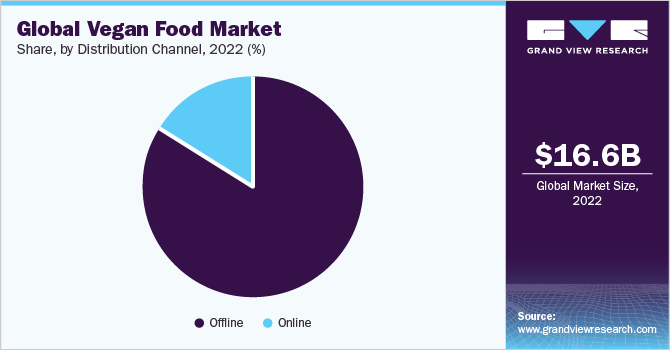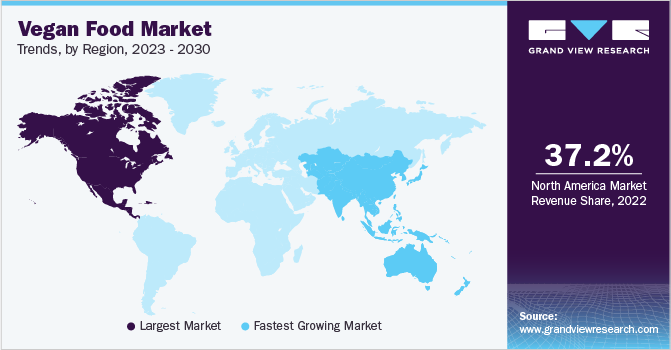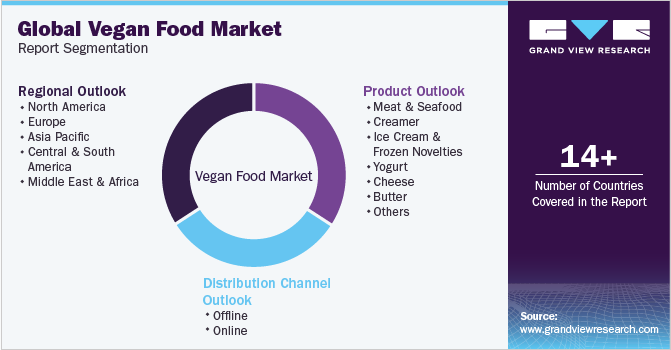- Home
- »
- Consumer F&B
- »
-
Vegan Food Market Size, Share And Trends Report, 2030GVR Report cover
![Vegan Food Market Size, Share & Trends Report]()
Vegan Food Market (2023 - 2030) Size, Share & Trends Analysis Report By Product (Meat & Seafood, Creamer, Ice Cream & Frozen Novelties, Yogurt, Cheese, Butter, Meals, Protein Bars, Others), By Distribution Channel, By Region, And Segment Forecasts
- Report ID: GVR-3-68038-103-0
- Number of Report Pages: 80
- Format: PDF
- Historical Range: 2017 - 2021
- Forecast Period: 2023 - 2030
- Industry: Consumer Goods
- Report Summary
- Table of Contents
- Segmentation
- Methodology
- Download FREE Sample
-
Download Sample Report
Vegan Food Market Summary
The global vegan food market size was estimated at USD 16.55 billion in 2022 and is projected to reach USD 37.5 billion by 2030, growing at a CAGR of 10.7% from 2023 to 2030. Increasing awareness about the benefits of following a vegan diet is the key factor driving the growth.
Key Market Trends & Insights
- North America accounted for the largest revenue share of over 37.2% in 2022.
- Asia Pacific is expected to emerge as the fastest-growing regional market and register a CAGR of 11.6% over the forecast period.
- Based on product, the meat & seafood segment contributed the largest market share of over 36.2% in 2022.
- By distribution channel, offline distribution channel segment held a larger share of over 83.8% in 2022.
Market Size & Forecast
- 2022 Market Size: USD 16.55 Billion
- 2030 Projected Market Size: USD 37.5 Billion
- CAGR (2023-2030): 10.7%
- North America: Largest market in 2022
- Asia Pacific: Fastest growing market
Rising concern about animal health and animal cruelty has been encouraging people to shift from animal-based to plant-based meals. Thus, the shift in preference of consumers is leading to an upsurge in consumption of vegan food. For instance, Grubhub, one of the major online food delivery apps accounted for the upsurge of 17% in overall vegan food deliveries in 2021. The COVID-19 pandemic took a toll on various industries including the food industry. Numerous significant shifts were experienced by the food industry due to shutdowns across the globe such as disruption of food supply chains, product distribution channels, and others.
However, the plant-based food category performed well during this situation. For instance, ShelfNow, an online food retailer accounted a 156% growth in vegetarian meal sales and a 150% upsurge in vegan meal sales between 2020 and 2021. Moreover, the various food retailers experience a significant increase in vegan food sales that further supported the growth of the market.
The production of vegan food is comparatively high in price compared to animal-based food owing to the high cost of plant-based ingredients used for the production. This factor is expected to restrain the adoption of vegan edible products in low and middle-income countries. However, various key players are adopting advanced technology to make significant advancements in the flavors and textures of plant-based meals which are expected to present key growth opportunities. For instance, Motif FoodWorks, Inc., a food technology company is working with extrudable fat technology and prolamin technology to develop plant-based meat and plant-based cheese.
Moreover, the growing popularity of plant-based food across the globe further supports market growth. This implies the increasing interest in veganism across the world. For instance, according to google trends from 2004 to 2022, the top regions with an interest in veganism include the U.K., Israel, New Zealand, Australia, and Austria. Moreover, a reduction has been observed in the consumption of meat among consumers. For instance, according to Gallup Poll, published in 2020, 23% of Americans reported eating less meat in 2019 as compared to 2018.
Additionally, the rising awareness of various health benefits offered by plant-based food products has increased the consumer base of this industry. Plant-based products help maintain blood pressure levels and lower the risk of heart disease, stroke, prostate cancer, colorectal cancer, cholesterol, and premature death. Moreover, the growing production of plant-based meat alternatives in the Asia Pacific region provides significant growth opportunities. For instance, in June 2020 Cargill, Incorporated launched its brand PlantEver in China, which is a plant-based consumer brand and will provide protein alternative options to consumers.
According to an article by the National Institute of Diabetes and Digestive and Kidney Diseases (NIDDK), around 68% of the global population has lactose malabsorption, which is a key factor boosting the demand for dairy alternative products such as plant-based milk, cheese, yogurt, ice cream, and frozen novelties. For instance, in February 2022, Gaia's Farming Co. launch two products in the milk alternative market that includes Hemp & Coco M*lk and Hemp & Oat M*lk. In addition, manufacturers in the market have introduced several quality products in different flavors with attractive packaging solutions, which is likely to contribute to industry growth over the forecast period.
By Product
Based on the product, the global vegan food market is further classified into meat & seafood, creamer, ice cream and frozen novelties, yogurt, cheese, butter, meals, protein bars, and others. Among these, the meat & seafood contributed the largest market share of over 36.2% in 2022. The segment is mainly driven due to the significant demand for plant-based meat substitutes in developed economies such as the U.S., U.K., and others.
The vegan cheese segment is expected to grow at a CAGR of 10.5% over the forecast period. Changing food habits and evolving trends in the food and beverage industry are driving the demand for vegan cheese across the globe. The high prevalence of lactose intolerance and other food-related allergies among children and adults contributes to the changing food preferences of consumers, which is expected to fuel the segment’s growth.
According to the data provided by the Food Intolerance Network, in 2020, around 70% of the population of the world suffered from lactose intolerance. Vegan cheese is widely used in Italian dishes, such as pasta, pizzas, croquettes, and Caprese salad, and is available in the form of slices, cubes, shredded, and spreads. The demand for vegan cheese is significantly high in countries where Italian cuisine is popular.
By Distribution Channel
Offline distribution channel held a larger share of over 83.8% in 2022. This segment includes convenience stores, specialty stores, hypermarkets, and supermarkets. The high number of supermarkets and hypermarkets has increased overall product sales. According to data published by ScrapeHero in November 2021, a total of 14,623 supermarkets are present in the U.S. including Walmart, The Kroger Co., and others.
Furthermore, consumers prefer shopping from brick-and-mortar grocers due to easy access and availability. Additionally, wide product availability of domestic and international brands along with physical verification of product details before any purchase also encourage consumers to purchase through offline stores.

The online distribution channel is expected to expand at a CAGR of 11.4% from 2023 to 2030 due to the rising penetration of the internet. As per the article published by Invesp around 48% of U.S. consumers buy at least some of their groceries through online retail and this percentage is expected to increase in the near future. As a result, many major retail chains across the world have been investing significantly in online distribution channels. Further, an increasing number of online grocery platforms such as Instacart, Amazon Fresh, Tesco, Morrisons Big Basket, and others is expected to boost the online sales of the products, thereby propelling the segment growth.
Regional Insights
North America accounted for the largest revenue share of over 37.2% in 2022. The market is mainly driven due to increased concerns about animal cruelty in the food industry and its negative impact on the environment. In addition, the U.S. has a large number of lactose-intolerant people, which fuels the demand for alternative dairy products.
According to an article published by The University of Alabama at Birmingham, 48% of Americans are intolerant to lactose. In the U.S. and Canada, the positive outlook toward plant-based meals among consumers as a result of an increased number of campaigns on social media and satellite television channels is projected to keep the dominance in the region.

Asia Pacific is expected to emerge as the fastest-growing regional market and register a CAGR of 11.6% over the forecast period. The market is mainly driven on account of rising health consciousness among consumers. Key manufacturers in the market have been focusing on expanding business in Asia Pacific due to high growth opportunities.
For instance, in December 2020, Nestlé launched its plant-based food brand Harvest Gourmet in China. The brand will provide a diverse range of plant-based products including mince, sausages, burgers, and nuggets. The growing demand for plant-based bakery and confectionery products in the Asia Pacific region is expected to fuel the sales. China, Japan, and Australia are the key contributors to regional growth.
Key Companies & Market Share Insights
The high demand for plant-based food has widened the scope of growth for manufacturers across the world. Thus, product innovation has been a major competitive strategy in this market. For instance:
-
In March 2023, Daiya Foods made investment to acquire fermentation technology in North America.
-
In July 2021, Upfield launched a vegan cheese brand Violife in the Middle East. The brand is an allergen-free, alternative range to dairy and is available in slices, boxes, and grated in two flavors such as cheddar and mozzarella.
-
In May 2021, a new plant-based brand Good & Gather was launched by Target. 30 plant-based products were launched under the brand.
-
In March 2020, Treeline Cheese launched a line of plant-based cream cheese that is made using cultured cashew nuts and various other plant-based ingredients. It is available in three flavors including plain, chive and onion, and strawberry.
Some prominent players in the global vegan food market include:
-
Amy's Kitchen
-
Danone S.A
-
Daiya Foods Inc.
-
Beyond Meat
-
Tofutti Brands Inc.
-
Plamil Foods Ltd
-
VBites Foods Limited
-
Eden Foods Inc.
-
VITASOY International Holdings Limited
-
SunOpta
Vegan Food Market Report Scope
Report Attribute
Details
The market size value in 2023
USD 18.2 billion
The revenue forecast in 2030
USD 37.5 billion
Growth Rate
CAGR of 10.7% from 2023 to 2030
Base year for estimation
2022
Historical data
2017 - 2021
Forecast period
2023 - 2030
Report updated
July 2023
Quantitative units
Revenue in USD billion and CAGR from 2023 to 2030
Report coverage
Revenue forecast, company ranking, competitive landscape, growth factors, brand share analysis, and trends
Segments covered
Product, distribution channel, region
Regional scope
North America, Europe, Asia Pacific, Central & South America, Middle East & Africa
Country scope
U.S.; Canada; Mexico; U.K.; Germany; France; Spain; Italy; China; Japan; India; South Korea; Australia; South Africa; Brazil
Key companies profiled
Amy's Kitchen; Danone S.A; Daiya Foods Inc.; Beyond Meat; Tofutti Brands Inc.; Plamil Foods Ltd; VBites Foods Limited; Eden Foods Inc.; VITASOY International Holdings Limited; SunOpta
Customization scope
Free report customization (equivalent up to 8 analysts working days) with purchase. Addition or alteration to country, regional & segment scope.
Pricing and purchase options
Avail customized purchase options to meet your exact research needs. Explore purchase options
Global Vegan Food Market Report Segmentation
This report forecasts revenue growth at global, regional & country levels and provides an analysis on the latest trends and opportunities in each of the sub-segments from 2017 to 2030. For the purpose of this study, Grand View Research has segmented the global vegan food market on the basis of product, distribution channel, and region.

-
Product Outlook (Revenue, USD Billion, 2017 - 2030)
-
Meat & Seafood
-
Creamer
-
Ice Cream & Frozen Novelties
-
Yogurt
-
Cheese
-
Butter
-
Meals
-
Protein Bars
-
Others
-
-
Distribution Channel Outlook (Revenue, USD Billion, 2017 - 2030)
-
Offline
-
Online
-
-
Regional Outlook (Revenue, USD Billion, 2017 - 2030)
-
North America
-
U.S.
-
Canada
-
Mexico
-
-
Europe
-
U.K.
-
Germany
-
France
-
Spain
-
Italy
-
-
Asia Pacific
-
China
-
Japan
-
India
-
South Korea
-
Australia
-
-
Central & South America
-
Brazil
-
-
Middle East & Africa
-
South Africa
-
-
Frequently Asked Questions About This Report
b. The global vegan food market size was estimated at USD 16.55 billion in 2022 and is expected to reach USD 18.20 billion in 2023.
b. The global vegan food market is expected to grow at a compound annual growth rate of 10.7% from 2023 to 2030 to reach USD 37.5 billion by 2030.
b. North America dominated the vegan food market with a share of 37.17% in 2022. This is attributed to the increasing demand for dairy alternatives due to the high prevalence of lactose intolerant population in the region along with growing concerns regarding cruelty against animals in the food industry.
b. Some key players operating in the vegan food market include Amy's Kitchen, Danone S.A, The Archer Daniels Midland Company, Daiya Foods Inc., Beyond Meat, Tofutti Brands Inc., Plamil Foods Ltd, VBites Foods Limited, Eden Foods Inc., and VITASOY International Holdings Limited
b. Key factors that are driving the market growth include increasing awareness about the benefits of following vegan diet and growing awareness about animal health and animal cruelty in the food industry.
Share this report with your colleague or friend.
Need a Tailored Report?
Customize this report to your needs — add regions, segments, or data points, with 20% free customization.

ISO 9001:2015 & 27001:2022 Certified
We are GDPR and CCPA compliant! Your transaction & personal information is safe and secure. For more details, please read our privacy policy.
Trusted market insights - try a free sample
See how our reports are structured and why industry leaders rely on Grand View Research. Get a free sample or ask us to tailor this report to your needs.










